Hong Kong–Zhuhai–Macau Bridge
The Hong Kong–Zhuhai–Macau Bridge (HZMB) is a 55-kilometre (34 mi) bridge–tunnel system consisting of a series of three cable-stayed bridges, an undersea tunnel, and four artificial islands. It is both the longest sea crossing[5][6] and the longest open-sea fixed link in the world. The HZMB spans the Lingding and Jiuzhou channels, connecting Hong Kong, Macau, and Zhuhai—three major cities on the Pearl River Delta.[7][8]
Hong Kong–Zhuhai–Macau Bridge 港珠澳大橋 港珠澳大桥 Ponte Hong Kong-Zhuhai-Macau | |
|---|---|
.jpg) | |
| Coordinates | 22°17′N 113°47′E |
| Carries | 6 lanes of the |
| Crosses | |
| Locale | Pearl River Delta |
| Official name | Hong Kong-Zhuhai-Macao Bridge |
| Other name(s) | HZMB, HZM Bridge |
| Website | hzmb.org (Mainland China) hzmb.gov.hk (Hong Kong) dsat.gov.mo/hzmb (Macau) |
| Characteristics | |
| Design | Bridge–tunnel system |
| Total length | 55 kilometres (34 mi) |
| No. of spans | 3 |
| No. of lanes | 6 |
| Design life | 120 years |
| History | |
| Construction start | 15 December 2009 |
| Construction end | 6 February 2018[1] |
| Construction cost | 127 billion yuan (US$18.8 billion)[2] |
| Opened | 24 October 2018, 09:00 UTC+8[3][4] |
| Inaugurated | 23 October 2018 |
| Statistics | |
| Toll | ¥80 - ¥200 Chinese Yuan; Free for car on occasion Chinese holiday |
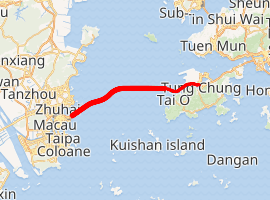
| |
| Hong Kong–Zhuhai–Macau Bridge | |||||||||||||
|---|---|---|---|---|---|---|---|---|---|---|---|---|---|
 | |||||||||||||
| Chinese name | |||||||||||||
| Traditional Chinese | 港珠澳大橋 | ||||||||||||
| Simplified Chinese | 港珠澳大桥 | ||||||||||||
| Jyutping | gong2 zyu1 ou3 daai6 kiu4 | ||||||||||||
| Hanyu Pinyin | Gǎngzhū'ào Dàqiáo | ||||||||||||
| |||||||||||||
| Portuguese name | |||||||||||||
| Portuguese | Ponte Hong Kong–Zhuhai–Macau | ||||||||||||
The HZM Bridge was designed to last for 120 years and cost 127 billion yuan (US$18.8 billion) to build.[2] The cost of constructing the Main Bridge was estimated at 51.1 billion yuan (US$7.56 billion) funded by bank loans and shared among the governments of mainland China, Hong Kong and Macau.[9]
Originally set to be opened to traffic in late 2016,[10][11][12] the structure was completed on 6 February 2018[1] and journalists were subsequently taken for a ride over the bridge.[13][14] On 24 October 2018, the HZMB was opened to the public after its inauguration a day earlier by Chinese leader Xi Jinping.
Planning
Background
Hopewell Holdings founder and then-managing director Gordon Wu proposed the concept of a bridge-tunnel linking China, Hong Kong and Macau in the 1980s.[15] Wu stated that he got the idea in 1983 from the Chesapeake Bay Bridge–Tunnel. In 1988, Wu pitched the concept to Guangdong and Beijing officials. He envisaged a link farther north than the current design, beginning at Black Point near Tuen Mun, Hong Kong and crossing the Pearl River estuary via Neilingding Island and Qi'ao Island. His proposed bridge would have ended at the Chinese village of Tangjia, and a new road would have continued south through Zhuhai before terminating at Macau.[16] Discussions stalled after the Tiananmen Square massacre in mid-1989 "unnerved" Wu and other foreign investors, and caused Hopewell's Hong Kong share prices to plunge.[17]
The route proposed by Wu was promoted by the Zhuhai government under the name Lingdingyang Bridge. In the mid-1990s, Zhuhai built a bridge between the mainland and Qi'ao Island that was intended as the first phase of this route, though the full scheme had not been approved by either the Chinese or Hong Kong governments at the time.[18] China's central government showed support for this project on 30 December 1997.[19] The new Hong Kong government was reluctant, stating that it was still awaiting cross-border traffic study results, and Hong Kong media questioned the environmental impact of the project with regard to air pollution, traffic and marine life.[20]
In December 2001, the Legislative Council of Hong Kong passed a motion urging the Administration to develop the logistics industry including the construction of a bridge connecting Hong Kong, Zhuhai and Macao. In September 2002, the China/Hong Kong Conference on Co-ordination of Major Infrastructure Projects agreed to a joint study on a transport link between Hong Kong and Pearl River West.[21]
Preparation
To coordinate the project, the Advance Work Coordination Group of HZMB was set up in 2003. Officials from three sides solved issues such as landing points and alignments of the bridge, operation of the Border Crossing Facilities, and project financing.[22]
In August 2008, China's Central Government, the governments of Guangdong, Hong Kong and Macau agreed to finance 42 percent of the total costs. The remaining 58% consisted of loans (approximately 22 billion yuan or US$3.23 billion) from the Bank of China.[23]
In March 2009, it was further reported that China's Central Government, Hong Kong and Macau agreed to finance 22 percent of the total costs. The remaining 78 percent consisted of loans (approximately 57.3 billion yuan or US$8.4 billion) from a consortium of banks led by Bank of China.[24]
Construction
Construction of the HZMB project began on 15 December 2009 on the Chinese side,[25] with then-Politburo Standing member and Vice Premier of China Li Keqiang holding a commencement ceremony. Construction of the Hong Kong section of the project began in December 2011 after a delay caused by a legal challenge regarding the environmental impact of the bridge.[26]
The last bridge tower was erected on 2 June 2016,[27][28] the last straighted-element of the 4,860-metre-long (15,940 ft) straight section of the undersea tunnel was installed on 12 July 2016,[29] while the final tunnel joint was installed on 2 May 2017. Construction of the Main Bridge, consisting of a viaduct and an undersea tunnel, was completed on 6 July 2017,[11] and the entire construction project was completed on 6 February 2018.[1] During the construction 19 workers died.[30][31]
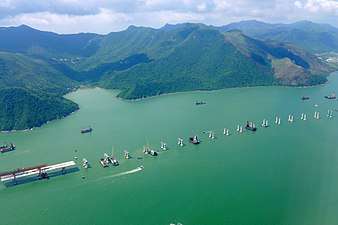 Hong Kong section under construction in 2015 off the coast of Lantau Island
Hong Kong section under construction in 2015 off the coast of Lantau Island The eastern artificial island in May 2017
The eastern artificial island in May 2017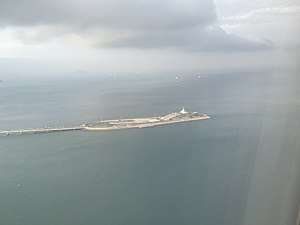 The Artificial Island in May 2018
The Artificial Island in May 2018 The completed Hong Kong section of the bridge in November 2018
The completed Hong Kong section of the bridge in November 2018
Sections and elements
The 55-km (34 mi) HZMB consists of three main sections: the Main Bridge (29.6 km or 18.4 mi) in the middle of the Pearl River estuary, the Hong Kong Link Road (12 km or 7.5 mi) in the east and the Zhuhai Link Road (13.4 km or 8.3 mi) in the west of the estuary.[32][33]
Main Bridge
The Main Bridge, the largest part of the HZMB project, is a bridge-cum-tunnel system constructed by the mainland Chinese authorities.[34] It connects an artificial island, housing the Boundary Crossing Facilities (BCF) for both mainland China and Macau in the west, to the Hong Kong Link Road in the east.
This section includes a 22.9-km (14.2 mi) viaduct and a 6.7-km (4.2 mi) undersea tunnel that runs between two artificial islands. The viaduct crosses the Pearl River estuary with three cable-stayed bridges spanning between 280 and 460 metres (920 and 1,510 ft), allowing shipping traffic to pass underneath.[35][36]
Hong Kong Link Road
.jpg)
Under Hong Kong jurisdiction, the Hong Kong Link Road was built by Highways Department to connect the Main Bridge to an artificial island housing the Hong Kong Boundary Crossing Facilities (HKBCF). This section includes a 9.4-km (5.8 mi) viaduct, a 1-km (0.62 mi) Scenic Hill Tunnel and a 1.6-km (1.0-mi) at-grade road along the east coast of the Hong Kong International Airport.[37][38][39][40]
Zhuhai Link Road
The Zhuhai Link Road starts from an artificial island housing the Boundary Crossing Facilities for both mainland China and Macau, passes through the developed area of Gongbei via a tunnel towards Zhuhai, and connects to three major expressways, namely, the Jing-Zhu Expressway, Guang-Zhu West Expressway and Jiang-Zhu Expressway.[41][42]
Left- and right-hand traffic
Although the HZMB connects two left-hand traffic (LHT) areas, namely Hong Kong and Macau, the crossing itself is right-hand traffic (RHT), the same as in Zhuhai and other regions of China. Thus, drivers from Hong Kong and Macau need to make use of crossing viaducts to switch to RHT upon entering the bridge, and back to LHT upon leaving the bridge when they are back to Hong Kong and Macau.[43][44] Traffic between Zhuhai and the bridge requires no left-right conversion as they are both RHT.[45]
Transport
Shuttle buses
.jpg)
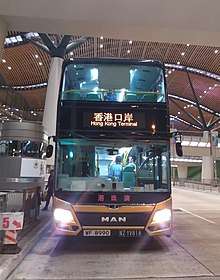
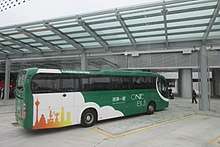
The HZMBus shuttle bus service runs 24 hours a day with bus departures as frequent as every five minutes.[46] The journey across the HZMB takes about 40 minutes.
The HZMB Hong Kong Port can be reached from Hong Kong by taxi or various buses including Cityflyer airport routes A11, A21, A22 and A29, Long Win Bus airport routes A31, A33X, A36 and A41, the B4 shuttle bus from Hong Kong International Airport, the B5 shuttle bus from Sunny Bay MTR station, or the B6 bus from Tung Chung.[47] In addition, all overnight airport buses (NA-prefixed routes) terminate and start service from the Hong Kong Port.
The HZMB Zhuhai Port can be reached from the mainland by taxis or the L1 bus which uses historic tourist vehicles, or Line-12, 23, 25 or 3 buses.[48]
The HZMB Macau Port can be reached from Macau by taxis or various buses including the 101X bus and the 102X bus from St Paul's and Taipa, or the HZMB Integrated Resort Connection bus from Taipa Ferry Terminal or the Exterior Ferry terminal, connecting with free casino shuttle buses.[49]
Private vehicles
Currently only 10,000 permits for private vehicles to drive across the HZMB from Hong Kong to Zhuhai are issued.[50] In addition, the number of vehicles permitted to enter Hong Kong and Macau from other regions is subject to a daily quota.[51]
Since the Hong Kong government imposes significant fees, taxes and administrative paperwork on private vehicle ownership and usage to deal with road congestion,[52] driving a car on the HZMB would incur the same restrictions as current cross-border traffic. These include applying for separate driving licences for both Hong Kong and mainland China, a Hong Kong Closed Road Permit for cross-boundary vehicles, and an Approval Notice from the Guangdong Public Security Bureau.[53][54] Vehicle owners also need to ensure they have the appropriate insurance coverage for the regions they are travelling to.[55]
In addition, to help compact Macau tackle its road congestion problems, drivers arriving from other regions are strongly encouraged to use a park and ride scheme, leaving their vehicles at a car park on the edge of Macau. A small quota of 300 vehicles are allowed to enter Macau directly.[56][57]
Economic effects
The HZMB links three major cities Hong Kong, Zhuhai and Macau, which are geographically close but separated by water. With the bridge in place, travelling time between Zhuhai and Hong Kong would cut down from about four hours to 30 minutes on the road.[58][59]
The HZMB project is part of a Beijing-driven strategy to create an economic hub and promote the economic development of the whole area of the Pearl River Delta, which is also known as Greater Bay Area.[60] Hoping to leverage the bridge and create an economic zone linking the three cities, Zhuhai's Hengqin area was designated as a free trade zone in 2015.[10]
Controversies
Delays and budget overruns
The artificial island housing the Hong Kong Boundary Crossing Facilities (HKBCF) was reported drifting due to an unconventional method, hitherto unused in Hong Kong, for land reclamation using a row of circular steel cells pile-driven into the mud and filled with inert material to form a seawall.[61]
The drifting of parts of the reclaimed island allegedly caused a delay in the HZMB project. The Highways Department denied various reports of movement up to 20 metres but admitted that parts of the reclaimed land had moved "up to six or seven metres",[62][63][64] claiming that some movement was expected and safety had not been jeopardised.[65]
Mainland contractors also reportedly had difficulty constructing immersed tubes for their section of the project, with the director of the Guangdong National Development and Reform Commission stating that 2020 would be a difficult target to meet.[63]
By 2017, the Main Bridge of the HZMB project had experienced a cost overrun of about 10 billion yuan, blamed on increased labour and material costs, as well as changes to the design and construction schemes.[66]
Worker deaths and injuries
The number of deaths and injuries during the construction project came under scrutiny in Hong Kong. In addition to 9 fatalities on the mainland side,[67] more than ten deaths were reported on the Hong Kong side of the construction project, plus between 234 and 600 injuries, depending on the source.[68] In April 2017, the Construction Site Workers General Union, the Labour Party and the Confederation of Trade Unions demonstrated at the Central Government Complex, demanding the government take action.[69]
Lawmaker Fernando Cheung also expressed concern over the unknown death toll on the Chinese side of the project, stating: "the project is known as the 'bridge of blood and tears' and we are only talking about the Hong Kong side. We don't even know what is happening in China. I suppose the situation could be 10 times worse than that in Hong Kong." He said that the Hong Kong Government had a responsibility to consider worker safety on the Chinese side.[69]
Faked safety testing
In 2017, Hong Kong's Independent Commission Against Corruption (ICAC) arrested 21 employees (two senior executives, 14 laboratory technicians and five laboratory assistants) of Jacobs China Limited, a contractor of the Civil Engineering and Development Department for falsifying concrete test results, thus potentially risking the safety of the bridge for public use.[70] In December 2017, a lab technician pleaded guilty and was sentenced to imprisonment for eight months, while the others await sentencing. Hong Kong's Highways Department conducted tests again after the falsified results were exposed and found all test results met safety standards.[71]
Seawall integrity
In April 2018, the public and media raised questions over the integrity of the seawalls protecting the artificial islands at both ends of the undersea tunnel. In footage taken by drone users and mariners, the dolosse installed at the edges of the artificial islands appear to have dislodged. Some civil engineers suggested that there was an error in design.[72][73] In dismissing the safety concerns, the HZMB Authority said the dolosse were designed to be submerged and the design was working as intended.[74] Director of Highways Department Daniel Chung denied on 8 April 2018 that the breakwater components had been washed away by waves.[75]
Subsequent aerial footage posted online showed a section of the dolosse breakwater completely underwater. Civil engineer So Yiu-kwan told Hong Kong media on 12 April 2018 that the water level, at the time the photos were taken, was about 1.74 mPD (metres above Principal Datum), but the maximum water level could reach 2.7 mPD. He said the dolosse would offer no wave protection if entirely submerged, and further alleged that they had been installed backwards.[76]
Impact on wildlife
Conservationists at WWF Hong Kong blamed the construction of the HZMB for the falling number of white dolphins in the waters near the bridge. The dolphins found near waters of Lantau were worst hit with numbers dropping by 60 percent between April 2015 and March 2016.[77]
See also
- Tuen Mun - Chek Lap Kok Link (short TM-CLK), tunnel from HZMB HK BCF to New Territories, under construction
- Environment of China
- Environment of Hong Kong
- Guangdong-Hong Kong-Macao Greater Bay Area
- Transport in China
- Transport in Hong Kong
- Transport in Macau
- Taiwan Strait Tunnel Project
- Qiongzhou Strait tunnel
- Bohai Strait tunnel
References
- 港珠澳大桥主体工程完成交工验收 具备通车试运营条件. Central People's Government of the People's Republic of China. 6 February 2018. Retrieved 24 October 2018.
- "Xinhua Headlines: World's longest cross-sea bridge opens, integrating China's Greater Bay Area". Xinhua Net. 23 October 2018. Retrieved 24 October 2018.
- "Cars and buses begin crossing the Pearl River Delta as Hong Kong-Zhuhai-Macau Bridge opens to traffic". 24 October 2018. Retrieved 24 October 2018.
- "Xi Jinping declares opening of Hong Kong-Zhuhai-Macau Bridge".
- "China opens longest sea-crossing bridge". BBC News. 23 October 2018. Retrieved 28 October 2018.
- hermes (25 October 2018). "Smooth start for world's longest state of the art sea crossing". The Straits Times. Retrieved 28 October 2018.
- "What's the Cost of a Ride on the World's Longest Bridge Over Water? - Caixin Global". www.caixinglobal.com. Retrieved 24 October 2018.
- "Satellite shots show epic scale of world's longest oversea bridge (IMAGES)". RT International. Retrieved 24 October 2018.
- Lazarus, Sarah. "China unveils world's longest sea-crossing bridge". CNN. Retrieved 28 October 2018.
- "Hong Kong-Zhuhai-Macau Bridge construction set to finish this year". Nikkei Asian Review. Retrieved 28 October 2018.
- "Main structure of Hong Kong-Zhuhai-Macao Bridge is completed". China Daily. 7 July 2017. Archived from the original on 20 July 2017. Retrieved 3 October 2017.
- The Standard. "Bridge to open in one go despite HK delays". Archived from the original on 22 October 2016. Retrieved 22 October 2016.
- Lazarus, Sarah. "China unveils world's longest sea-crossing bridge". CNN. Retrieved 16 August 2018.
- 好消息!港珠澳大桥七一前正式通车_大粤网_腾讯网. gd.qq.com (in Chinese). Archived from the original on 9 February 2018. Retrieved 8 February 2018.
- Tsang, Denise (23 October 2018). "Tycoon's 35-year dream finally realised as mega bridge opens". South China Morning Post. Retrieved 23 October 2018.
- Stoner, Tad (3 November 1988). "$6b bridge to China plan". South China Morning Post. p. 1.
- Hunt, Christopher (29 December 1989). "Entrepreneur Becomes a Weather Vane For Resuming Business in China Now". The Wall Street Journal, Eastern edition. p. 1.
- Cheung, Agnes (29 March 1995). "First Lingdingyang link nearly ready". South China Morning Post. p. 11.
- Szeto, Wanda; Ng, Kang-chung (31 December 1997). "Beijing approves Zhuhai-HK bridge". South China Morning Post. p. 1.
- "A bridge too far". South China Morning Post. 2 January 1998. p. 12.
- "Hong Kong - Zhuhai - Macao Bridge (HZMB)".
- "Introduction to Hong Kong-Zhuhai-Macao Bridge - Hong Kong-Zhuhai-Macao Bridg". www.hzmb.org. Retrieved 27 October 2018.
- Bi, Mingxin (14 April 2009). "Bank of China to lead loan consortium for Hong Kong-Zhuhai-Macao Bridge". Window of China. Xinhuanet. Archived from the original on 24 October 2012. Retrieved 17 April 2009.
- Cheng, Jonathan (15 December 2009). "China Builds Bridge to Link Southern Cities". The Wall Street Journal. Dow Jones & Company. Archived from the original on 13 October 2017. Retrieved 15 December 2009.
- Arup: "Hong Kong-Zhuhai-Macao Bridge ground breaking" Archived 19 July 2013 at the Wayback Machine 19 July 2013 at the Wayback Machine. , 9 February 2010. Retrieved 22 December 2011.
- Macau Daily Times: "Pearl River Delta Bridge work begins" Archived 10 June 2012 at the Wayback Machine 10 June 2012 at the Wayback Machine. , 15 December 2011. Retrieved 22 December 2011.
- "HK-Zhuhai-Macao Bridge about to open to traffic". Archived from the original on 8 June 2016.
- "Final HZMB Bridge Tower Erected". Archived from the original on 18 October 2016.
- "HongKong-Zhuhai-Macao Bridge". Archived from the original on 18 October 2016. Retrieved 14 October 2016.
- "【港珠澳血橋】工會促為殉職工人立碑 政府無反應 工程公司70年代萬宜水庫立碑紀念工人". 19 October 2018. Retrieved 15 June 2019.
- "未來城市:建工傷紀念碑 是療傷也是讓民族向前行". 18 November 2018. Retrieved 15 June 2019.
- "China border control at sea crossing". The Standard. Retrieved 27 October 2018.
- "Hong Kong - Zhuhai - Macao Bridge". www.hzmb.gov.hk. Retrieved 27 October 2018.
- "HZMB Main Bridge". Highways Department (Hong Kong). Retrieved 16 August 2018.
- Website of Transport and Housing Bureau (HKSAR): "Cross boundary traffic: Hong Kong-Zhuhai-Macao Bridge" Archived 18 January 2010 at the Wayback Machine 18 January 2010 at the Wayback Machine. . Retrieved 22 December 2011.
- Arup (a consulting company involved in the design of the bridges): "Hong Kong–Zhuhai–Macao Bridge overview" Archived 15 January 2010 at the Wayback Machine 15 January 2010 at the Wayback Machine. . Retrieved 22 December 2011.
- "HongKong-Zhuhai-Macao Bridge (HZMB) : Hong Kong Link Road". www.hzmb.hk. Retrieved 27 October 2018.
- "Bridge link road surfacing completed". Hong Kong's Information Services Department. Retrieved 27 October 2018.
- "Plot of Hong Kong - Zhuhai - Macao Baridge - Hong Kong Link Road" (PDF).
- "Hong Kong Link Road (HKLR)" (PDF).
- "HongKong-Zhuhai-Macao Bridge (HZMB) : Connectivity to Pearl River West". www.hzmb.hk. Retrieved 27 October 2018.
- Yeung, Albert (29 January 2016). "Geotechnical works of the Hong Kong-Zhuhai-Macao Bridge Project". Japanese Geotechnical Society Special Publication. 2 (2): 109–121. doi:10.3208/jgssp.ESD-KL-3.
- "Cars may drive on the right on Hong Kong-Zhuhai-Macao Bridge, despite city's left-hand traffic arrangement | Hong Kong Free Press HKFP". Hong Kong Free Press HKFP. 21 February 2017. Retrieved 1 November 2018.
- "Interface of "Left-driving" & "Right-driving" Arrangement".
- Su, Xinqi; Yeung, Raymond (13 February 2018). "Right side of road the only way to travel on Hong Kong-Zhuhai-Macau bridge". South China Morning Post.
- "HZMBus". www.hzmbus.com. Retrieved 22 November 2018.
- "Shuttle bus services at Hong Kong Port (in Chinese)". www.hzmbus.com. Retrieved 23 November 2018.
- "Shuttle bus services at Zhuhai Port (in Chinese)". www.hzmbus.com. Retrieved 23 November 2018.
- "Shuttle bus services at Macau Port (in Chinese)". www.hzmbus.com. Retrieved 23 November 2018.
- "Zhuhai bridge to allow 7,000 more cars after high demand". South China Morning Post. Retrieved 25 October 2018.
- "Transport Department - Regular Quota for Hong Kong Private Cars to Macao (Access to City Centre)". www.td.gov.hk. Retrieved 22 October 2018.
- "The cost of owning a car in Hong Kong". www.moneyhero.com.hk. 7 November 2014. Retrieved 22 October 2018.
- (www.gov.hk), GovHK. "GovHK: Cross-boundary Driving". www.gov.hk. Retrieved 22 October 2018.
- "Transport Department - Closed Road Permit for Cross-boundary Vehicles". www.td.gov.hk. Retrieved 22 October 2018.
- "Insurance Authority - Motor insurance for using Hong Kong-Zhuhai-Macao Bridge (HZMB)". www.ia.org.hk (in Chinese).
- "Rules for using Macao car park at HKZM Bridge published".
- "Macau sets 300 quota for HK cars driving via mega bridge".
- "World's longest sea crossing: Hong Kong-Zhuhai bridge opens". BBC News. 23 October 2018. Retrieved 27 October 2018.
- 郭凯. "Main structure of Hong Kong-Zhuhai-Macao Bridge is completed[1]- Chinadaily.com.cn". www.chinadaily.com.cn. Retrieved 28 October 2018.
- "China's president launches Hong Kong-mainland mega bridge - ASEAN Plus | The Star Online". www.thestar.com.my. 23 October 2018. Retrieved 27 October 2018.
- "Newsletter 2012 July" (PDF). Hong Kong-Zhuhai-Macao Bridge and Related Hong Kong Projects. Highways Department. July 2012. Archived (PDF) from the original on 26 November 2015.
- "Island drift threatens further delays in cross-border bridge". Hong Kong Economic Journal. 23 September 2015. Archived from the original on 26 November 2015.
- Winn, Howard (25 November 2015). "Delays of up to 5 years for HK$30bn 'moving' Macau bridge crossing facilities". Hong Kong Free Press. Archived from the original on 26 November 2015.
- Siu, Phila; Lee, Eddie (24 September 2015). "Seven-metre drift on Hong Kong artificial island reclaimed for bridge project is normal, say officials". South China Morning Post. Archived from the original on 19 November 2015.
- Ng, Kang-chung (25 September 2015). "Shifting sands: 'flaws' blamed for problems at artificial island for Hong Kong-Zhuhai-Macau bridge". South China Morning Post. Archived from the original on 30 November 2015.
- "China stretch of Hong Kong-Zhuhai-Macao Bridge hits another budget overrun totalling HK$11.7 billion". 22 November 2017. Archived from the original on 6 December 2017. Retrieved 6 December 2017.
- "China opens longest sea-crossing bridge". BBC News. 23 October 2018. Retrieved 27 October 2018.
- Ng, Ellie (11 April 2017). "Lawmakers slam gov't over 'misleading' death rates related to HK-Zhuhai-Macau bridge project". Hong Kong Free Press. Archived from the original on 13 April 2017.
- Ng, Ellie (12 April 2017). "Gov't 'regrets' fatalities at Hong Kong-Zhuhai-Macau bridge project, as workers demand halt to 'murders'". Hong Kong Free Press. Archived from the original on 14 April 2017.
- Ng, Ellie (24 May 2017). "'Fake' lab tests at mega bridge project damage trust in gov't, lawmakers warn". Hong Kong Free Press.
- Cheng, Kris (1 December 2017). "Lab technician jailed for 8 months after falsifying Hong Kong-Zhuhai-Macao bridge test records". Hong Kong Free Press.
- Clark, Robert (5 April 2018). "This week's bridge problem: tunnel faces flooding threat". Lantau News.
- Cheng, Kris (3 April 2018). "HK-Zhuhai-Macao Bridge components found drifting from artificial island, as authority claims it may be an 'illusion'". Hong Kong Free Press.
- "Drifting away? Concerns over Hong Kong-Zhuhai-Macau bridge dismissed". South China Morning Post. Retrieved 29 October 2018.
- "Hong Kong-Zhuhai-Macao Bridge breakwater design scientific, reasonable and safe, says top gov't official | Hong Kong Free Press HKFP". Hong Kong Free Press HKFP. 10 April 2018. Retrieved 29 October 2018.
- Cheng, Kris (12 April 2018). "Sea bridge island's breakwater blocks offer no protection as they are underwater at high tide, says veteran engineer". Hong Kong Free Press.
- "Experts blame Hong Kong-Zhuhai-Macau Bridge for falling dolphin numbers". SCMP. Retrieved 28 October 2018.
External links
| Wikimedia Commons has media related to Hong Kong–Zhuhai–Macau Bridge. |
- Official website (Chinese website)
- Official website (Hong Kong website)
- Official website (Macau website)
- Official website (shuttle bus operator)
- Save our Shoreline
- Designing HK, Tung Chung Sustainable Development
- Hong Kong-Zhuhai-Macao Bridge at Structurae
- Three cities, one bridge, graphics package by South China Morning Post with Landsat satellite images of the bridge